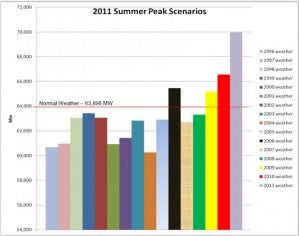As Texans celebrated the Summer solstice last week, the forecast for this week’s weather was simultaneously making people uneasy. With practically all of Texas, from El Paso to the Panhandle and the Coast, hitting 100+ degrees the only solace is that we were spared triple digits for the majority of June. Despite this respite, it was by no means a cool spring. According to the National Climactic Data Center, “Texas had its warmest spring (March through May) on record and its third warmest January-through-May period“.
This heat is not only uncomfortable for the people living in it, but it also puts a strain on our electric grid as demand increases. According to the Electric Reliability Council of Texas (ERCOT), “peak-hour power consumption could exceed 66,000 megawatts (MW) Monday afternoon, surpassing the monthly records for June of last year and straining the state’s electric resources.” ERCOT goes on to conclude that it “expects to have adequate generation and surplus available to serve the state without imposing emergency programs that could lead to curtailment of power to certain industrial customers or broader rolling outages,” however warning, “that rolling outages could occur this summer given the state’s limited amount of surplus generation.”
So what is ERCOT planning for?
ERCOT is projecting weather, and thus electricity usage, using a “normal weather” baseline that reflects more a 2007 outlier (an abnormally cool and lush summer) than it does the actual trajectory of increasing temperatures year after year from 2006 to 2011. Their “normal weather” equates to a usage of 63,898 MW.
But we are breaking records yet again. In May, we already set a “monthly power demand record of 59,037 MW, surpassing the previous high set in May 2011 by 2.9 percent, and an all-time ERCOT’s peak of 68,379 MW was set last August.” And this week, as predicted, “Tuesday broke the new peak demand record it set Monday. Electric use during the 4-5 p.m. hour reached 66,583 MW, also exceeding the standing record for July”. Typically in the high 80’s this time of year, Galveston reached 100 degrees in June for the first time ever.
Despite, breaking records this June, and hitting that all-time peak of 68,379 MW last August, ERCOT’s projection for peak summer demand in 2013 is around 67,168 MW. This is a risky projection, but the good news is that this peak amount includes reductions that come from demand response (DR) and energy efficiency mechanisms thus allowing for a firm forecast of 65,649 MW instead. We argue that if restrictions were lifted for demand response (DR) and energy efficiency measures were not being gutted we would cut that amount even further, avoiding the need for ramping up polluting peaker plants and building new ones.
PUC Chairman Nelson also reflected uncertainty as to the reliability of our grid when she said, “You know, we want to get the message out of reduced usage during peak demand…At the same time, we want to get the message out ‘Texas is open for business. We want to get the message out, peak demand, turn your thermostat up a couple degrees, don’t do your laundry, those kinds of things. But we don’t want to say, ‘if you don’t we’ll have rolling outages’, OK? So, it’s a fine line to walk.”
However, as we reported a few weeks ago, parts of the PUC’s proposed rules would actually hurt energy efficiency programs and decrease the effectiveness of current programs by adding unnecessary red tape and discouraging efficiency. The same types of programs that help shore up ERCOT’s peak demand projections for next year. Right when efficiency needs to expand, the PUC instead is making it more difficult. Why this mixed message?
John Moura, the reliability assessment manager at NERC, the North American Electric Reliability Corp., said “the ‘million-dollar question’ is what will happen if Texas sees a repeat of Aug. 3, 2011, when a prolonged heat wave led to a state record for electricity demand. If power lines go down, the wind stops blowing or drought forces a power plant to stop sucking up water to cool its equipment, the state could be in trouble.”
















